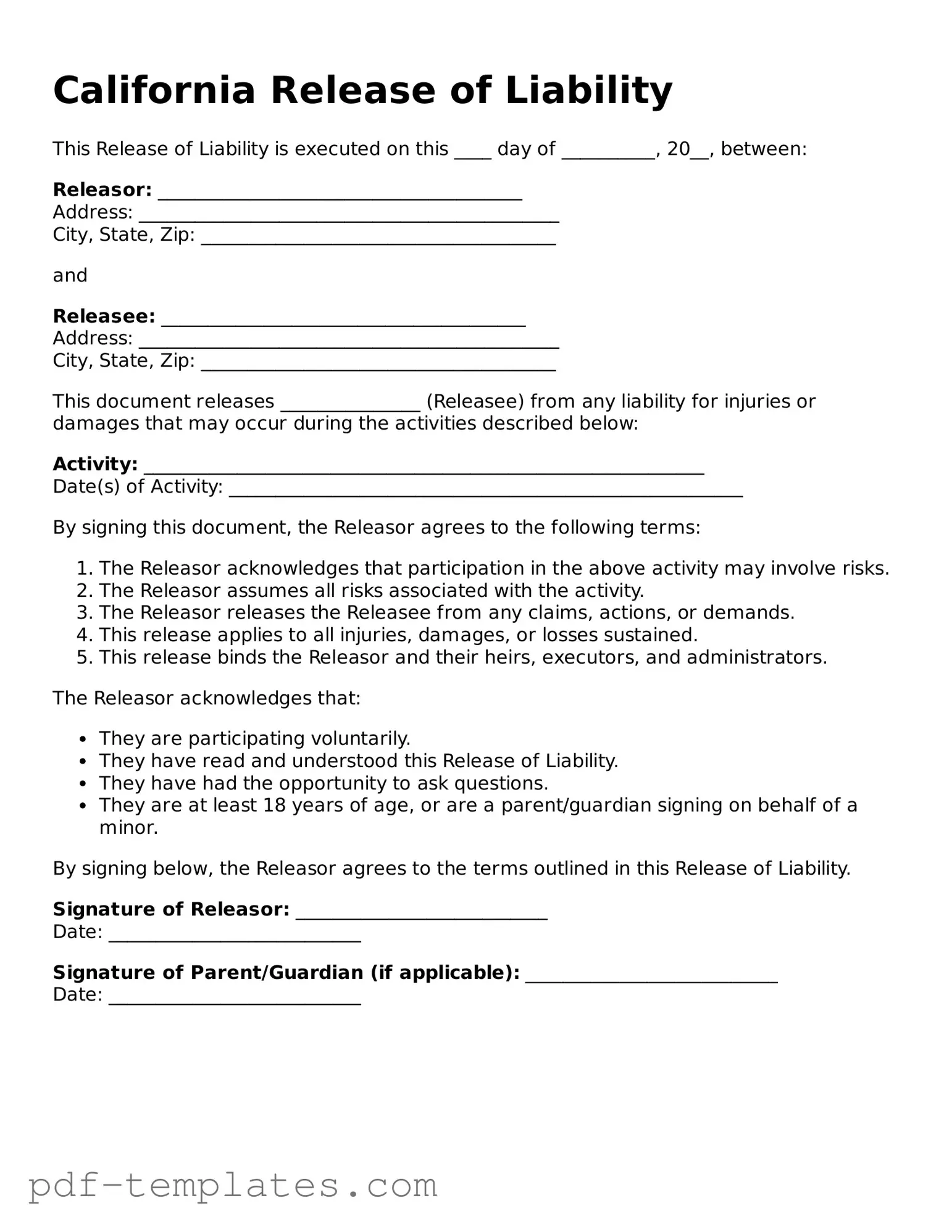The California Release of Liability form shares similarities with the Waiver of Liability form. Both documents are designed to protect organizations and individuals from legal claims resulting from injuries or damages. By signing a Waiver of Liability, participants acknowledge the risks associated with an activity and agree not to hold the provider responsible for any harm that may occur. This mutual understanding is crucial in various settings, from sports events to recreational activities.
Another document akin to the Release of Liability is the Indemnity Agreement. This agreement involves one party agreeing to compensate another for any losses or damages that may arise. While the Release of Liability focuses on preventing claims, the Indemnity Agreement emphasizes financial responsibility. Together, they create a comprehensive framework for managing risk in contractual relationships.
The Consent to Participate form also bears resemblance to the Release of Liability. This document is often used in activities where participants must acknowledge their understanding of the risks involved. By signing, individuals confirm their willingness to engage in the activity despite potential hazards. This form is particularly common in sports and recreational programs, where safety is a primary concern.
The Assumption of Risk Agreement is another document similar to the Release of Liability. This agreement explicitly states that participants accept the inherent risks associated with an activity. By signing, individuals acknowledge that they understand the dangers involved and agree to take responsibility for their own safety. This agreement is frequently utilized in adventure sports and other high-risk activities.
The Participant Agreement is also comparable to the Release of Liability. This document outlines the terms and conditions under which individuals can participate in an event or activity. It often includes clauses that limit the liability of organizers and providers, ensuring that participants are aware of their rights and responsibilities. Clarity in these agreements helps foster a safe environment for all involved.
The Medical Release form is another related document. While it focuses more on health and safety, it often accompanies liability releases in activities that may pose medical risks. Participants provide consent for medical treatment in case of an emergency, ensuring that organizers can act swiftly if an injury occurs. This form complements the Release of Liability by addressing health concerns while mitigating legal risks.
The Hold Harmless Agreement is similar in purpose to the Release of Liability. This document protects one party from legal claims or lawsuits that may arise from another party’s actions. By signing, the individual agrees not to pursue legal action against the party providing the service or activity. This agreement is common in contracts where one party seeks to minimize their exposure to liability.
The Release of Claims form also parallels the Release of Liability. This document allows individuals to waive their right to pursue legal action for specific claims against another party. It serves as a proactive measure to prevent disputes by ensuring that all parties understand the limitations of liability. This form is often used in various transactions, including real estate and service agreements.
The Disclaimer of Liability is another document that shares similarities with the Release of Liability. This notice informs participants of potential risks associated with an activity or service and typically states that the provider will not be held responsible for any injuries or damages. While it may not require a signature, it serves a similar purpose in managing expectations and protecting against liability.
Lastly, the Liability Insurance Waiver is comparable to the Release of Liability. This document allows individuals to waive their right to claim damages under an insurance policy. By signing, they acknowledge that they understand the risks and agree to forgo insurance coverage for specific activities. This waiver is often used in high-risk environments where insurance may not cover certain incidents.
